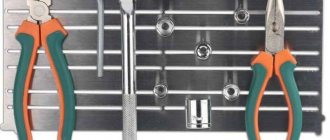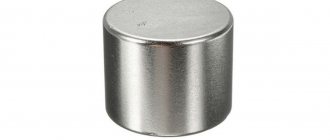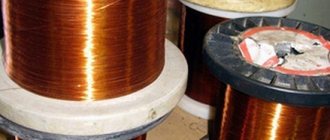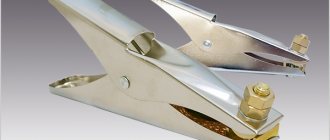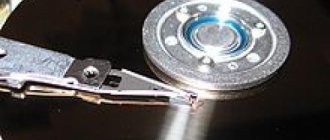The strongest and most powerful permanent magnet currently available for sale is the neodymium magnet. Such magnets have the chemical formula Nd2Fe14B, and have an exceptional magnetic energy density reaching 512 kJ/m3. If previously samarium-cobalt (SmCo) magnets were considered the most powerful commercially available, then, starting in 1986, they were gradually replaced by neodymium magnets, which were much more economical in production costs, although with a lower Curie temperature.
With the development of the electronics industry, from the 90s to the present, neodymium magnets have gained great popularity everywhere, and many are still surprised by their remarkable properties, because such a magnet can lift a load thousands of times greater than the weight of the magnet itself.
Neodymium magnet
It all started when in 1982 the Japanese company Sumitomo Special Metals, working together with the American General Motors on the problem of finding an alternative to expensive samarium-cobalt (SmCo) magnets, found a neodymium-iron-boron compound, which was patented by General Motors in 1985 In 1986, the Magnequench company was opened, specializing in the production of neodymium magnets and selling raw materials for their manufacture.
Magnequench later became part of Molycorp, USA, and Sumitomo became part of Hitachi Corporation, Japan, and Hitachi now holds more than 600 patents related to the production of neodymium magnets by sintering and licenses numerous facilities around the world.
In the end, China became the leader in the production of neodymium magnets, because this country controls a huge share of the world's rare earth ores.
China produces 50,000 tons of neodymium magnets every year. Meanwhile, one ton of the original ore contains about 700 kg of iron, and neodymium - a maximum of 450 grams.
Neodymium
For the manufacture of neodymium magnets, powder technology is used, which makes it possible to produce three types of magnets: pressed magnets, cast magnets, and sintered magnets.
Before making magnets, magnetic material is smelted; for this, the initial elements (iron, neodymium, boron) are fused in an induction furnace, then the resulting alloy is crushed, obtaining powder for further stages of the technological process, for working with the powder.
Characteristics of neodymium magnets
Depending on the microstructure of the starting elements, the magnetic properties of the final product may vary to some extent. Often the Nd2Fe14B compound is used directly. It is its structure that gives the maximum magnetocrystalline, uniaxial anisotropy. But more complex chemical reactions are also possible.
Sintered magnetoplasts
They are obtained by pressing neodymium-iron-boron powder, sintering it in an inert or vacuum environment, and then grinding it on a machine until the desired shape is obtained. During the pressing of the powder, it is acted upon by a magnetic field of the required intensity and direction, which sets the magnetization.
Cast magnets
They are obtained using polymers that are mixed with neodymium-iron-boron powder and then extruded into a mold, and here it is possible to obtain any shape, however, the energy of the product is limited to 5 MGE.
Pressed magnetoplasts
They are obtained as follows: the original neodymium-iron-boron powder is mixed with a polymer, then pressed into a shape, heated and magnetized. No additional processing is required, and the energy of pressed magnetoplasts is limited to 10 MGse.
How are neodymium magnets made?
The unique properties of neodymium magnets are associated, among other things, with the modern method of their production. It involves pressing individual raw materials at very high temperatures and then gluing or sintering them.
It is important to note that all metals cannot be melted, and their processing at each stage occurs only in powder form. The finally joined materials are exposed to a strong magnetic field, which ensures their exceptional functional properties.
Strong search magnets equipped with a handle are primarily used when searching for various types of metal elements in hard-to-reach places. These products have a dense body with an anti-corrosion coating, which means that the magnet itself will not lose its magnetic properties or be damaged under water. Magnetic holders are widely used when exploring the bottom of reservoirs in search of various metal elements. Thanks to its magnetic properties, the search magnet 400 is very well suited for working in difficult weather conditions. Due to the high power of the magnetic force, it can be used to search and retrieve sunken vehicles and special equipment and even metal meteorites. In this case, larger holders containing very strong neodymium magnets are used.
Clamps
If you need to glue two surfaces, but due to the complexity of the shape it is not possible to use a vice, magnetic parts will again help solve the problem. Simply place the objects to be glued between them, which, due to the attractive force of neodymium, will be tightly pressed to each other.
Using this kind of clamps, you can easily clean or wash surfaces that seemed completely inaccessible. Where are neodymium magnets used specifically? For washing the external surfaces of balcony glass, cleaning an aquarium and other hard-to-reach glass containers. Place the magnetic bar inside the washcloth, which you secure on the outside of the balcony, holding it with another magnet from the inside. This way, you can direct the external sponge wherever you want and clean the glass perfectly.
Ring neodymium magnet
These types of neodymium magnets are usually coated with a nickel-plated protective coating, which is additionally designed to prevent corrosion, rusting, and harmful external factors. It also protects the human skin and body from the harmful effects of magnet components. Strong neodymium ring magnets have very specific magnetic properties. In them, the direction of magnetization goes along the diameter, so the poles of the magnet are evenly distributed over half of its diameter. Thus, one half of the diameter has a north pole (N) and the other half of the diameter has a south pole (S).
The maximum operating temperature of this type of magnet is usually 80 degrees Celsius unless it is reinforced with an additional protective coating. Neodymium ring magnets are cylindrical with a hole in the center, disk or other similar shapes with a hole. They fit perfectly where it is best to secure this type of magnet with a screw.
Cleaning
By attaching a sponge with a magnet inside the aquarium and placing another magnet outside such a structure, you can clean it without getting your hands dirty. A magnet moving inside will press the sponge, forcing it to clean the dirty surface of the glass from the inside. This solution is effective if you do not want to come into contact with water or the results of the life activity of aquarium inhabitants.
Cylindrical neodymium magnet
Oval Cylindrical Neodymium Magnet is a very characteristic type of neodymium magnet. Typically magnetized in the axial direction, it is therefore used in many industries. Typically, neodymium cylindrical magnets are additionally made of nickel and copper plating, making them very resistant to damage. They are in no way dangerous to humans and do not affect the human skin or body.
The main applications of strong neodymium cylindrical magnets are, in particular:
- metal detectors,
- oil filters,
- toys,
- jewelry elements,
- elements of door handles of various types,
- cabins and other elements.
Tiny neodymium magnets are commonly used to make various refrigerator magnets.
Search and collection of metal objects
Now you will not have problems finding iron objects that have rolled under furniture or fallen into a well. Simply attach, for example, a magnetic disk to the end of a stick or tie it to a cord and move this simple device over the place where the object is likely to fall. In just a few minutes, what you lost will be in your hands safe and sound.
The use of a neodymium magnet will also help to collect metal shavings or scattered screws. For convenience, wrap the neodymium item in a cloth, sock or plastic bag. This will help, on the one hand, to protect the work surface from the adhesion of iron debris, and on the other hand, to remove everything that is stuck at once and not separate each screw separately.
Plate neodymium magnets
Neodymium plate magnets are used in various industries and in everyday life. The use of neodymium plate magnets has made it possible, among other things, to reduce the size of magnetic systems and their weight.
In addition, magnets of this type can also be equipped with additional protective coatings that will allow them to operate at much higher temperatures - up to 200 degrees Celsius. The type of magnetization of this type of shape occurs along the smallest dimension. Strong neodymium plate magnets are mainly used in various types of electric motor models, for cabinet handles and various types of furniture lids.
Communal trick
A neodymium magnet can not only slow down, but also completely stop the meter mechanism for water, gas, and light. By installing it in a secret place, you can avoid problems with government verification services and save a decent portion of budget funds. True, this method has already become dangerous, since state control has learned to deal with such tricks. In general, a neodymium magnet has an unlimited service life, is quite multifunctional, easy to use and has convenient sizes. You can buy large magnets of various weights and shapes here.
- PASSIVE COOLING OF CHIPS
- SELECTING A PULSE PSU WHEN PURCHASING
- AMATEUR RADIO WORKPLACE
Where is neodymium magnet used?
Because neodymium magnets have the strongest magnetic field of any magnet known to us, they have found widespread use in both general applications and many industrial applications. Depending on the type of magnet and its shape, strong neodymium magnets are used in various industries. We can find magnets in the computer, household and textile industries. The use of neodymium magnets primarily depends on the demand for magnets with a strong magnetic field.
Products of this type are widely used in:
- industry (magnetic holders),
- automotive industry for various types of oil cleaners from metal filings (cylindrical magnets),
- simulation in the production of high quality brushless motors for automobiles and aircraft models (plate magnets).
Strong neodymium magnets are also used in the furniture industry. For example, for the manufacture of various furniture locks and handles, as well as glass display cases. Neodymium magnets allow you to create different types of products using strong magnetic induction. An example would be electric motors.
Auto
You can get rid of chips and other metal debris in engine oil by using a neodymium magnet; there is a video about this on the Internet. Attach a magnetic device to the crankcase drain plug, neodymium will attract iron microparticles, and they will not get into the working mechanisms of the car.
With the help of a small neodymium plate, you can also secure any objects to the car body, and with the help of large magnetic disks or bars you can even even out small dents.
Magnets on sale
In fact, magnets can be found in the most unpredictable places. These could be knife holders in the kitchen, wall clocks, various figurines, jewelry, and decorative items. In general, any objects that have magnetic properties can contain neodymium. The question is whether a magnet found at home in a household appliance or hard drive is suitable in terms of power and size... Also, industrial magnets are made with a thread or hole of the required shape and diameter. If a neodymium magnet is needed for business, then it is better to think about buying a real large magnet.
Electrical engineering
| REPLACING THE PHILIPS VACUUM CLEANER MOTOR |
How to choose a search magnet
Search magnets differ in design, use cases, weight, power and size. Such diversity takes a beginner by surprise. Techniques and life hacks for successful “magnetic fishing” will help you choose a search magnet.
Single sided or double sided
There are two main types of search magnets used in different directions
The choice depends on the conditions of use, so before you buy a single-sided or double-sided unit, it is important to compare their advantages and disadvantages:
| Characteristic | Single sided magnet | Double sided magnet |
| Grip on object | The find is magnetized at the end, so even when working on a rocky bottom, the likelihood of unhooking is low. | Thanks to two working surfaces, it easily attracts an object, but is more likely to be lost when colliding with an obstacle. |
| Terms of Use | The unit is perfect for “vertical fishing”. It is more convenient to search while in a boat or on a bridge. The magnet enters perpendicularly into the water without turning over. | A universal magnet with a double surface that can be used in any environment. It will attract objects, even upside down. |
| Weight | The lightweight device is great for long searches. | A double-sided magnet is a third heavier than a single-sided one, which leads to rapid fatigue of the search engine. |
| Design | It has one eye-bolt fastening and a single working surface. | Equipped with two surfaces and fastenings. |
What weight of search magnet to choose
The average weight of search magnets is 0.2-4 kg. In your arsenal you need to have a unit with a force of attraction of at least 100-200 kg. By purchasing such a device, a search engine will be able to lift a flat metal plate with a smooth and clean surface or small objects from the bottom. In real conditions, fouling with silt, algae, and current weakens the effect of the magnet. As a result, it turns out that having an attractive force of 100 kg, the structure will overpower an object weighing no more than 7-10 kg.
Based on reviews from owners, it is better to choose a magnet with more powerful characteristics - 200-400 kg. They will magnetize interesting things, bypassing priceless pieces of hardware.
You can also buy a magnet for searching in water to make money, but in this case you will need a power in the range of 600-800 kg. Despite their modest weight, they are able to overcome mountains of metal. With their help you can find bicycles, motorcycles and remains of cars.
Table of sizes and main characteristics of search magnets
| Model | D (mm) | H (mm) | M (mm) | Weight (kg) | Force (kg/s) |
| F150 | 68 | 14 | 8 | 0,4 | 190-210 |
| F200 | 75 | 16 | 8 | 0,5 | 230-250 |
| F250 | 86 | 21 | 10 | 0,9 | 320-340 |
| F300 | 97 | 22 | 10 | 1,3 | 430-450 |
| F400 | 107 | 22 | 10 | 1,5 | 530-560 |
| F600 | 130 | 24 | 12 | 2,6 | 690-720 |
| F800 | 132 | 28 | 12 | 3,1 | 820-850 |
| F150x2 | 67 | 24 | 8 | 0,7 | 190-220 |
| F200x2 | 75 | 28 | 8 | 0,9 | 250-280 |
| F250x2 | 86 | 33 | 10 | 1,4 | 330-360 |
| F300x2 | 97 | 35 | 10 | 1,9 | 430-450 |
| F400x2 | 107 | 35 | 10 | 2,2 | 540-570 |
| F600x2 | 130 | 39 | 12 | 4,0 | 690-720 |
Objective rating of search magnets
At the moment, the absolute market leaders are:
- Forceberg F-200. A model that rightfully tops the list of the best search magnets due to its characteristics. Despite its modest dimensions, it provides traction of 220 kg. And two eye bolts are used to separate the magnet from the find and make searching easier. Wear less than 1% in 10 years.
- Redmag F-200. The modification is famous for its compliance with the specified power declared by the manufacturer. The maximum tensile strength of the presented model is 200-225 kg. An improved design made of metal and neodymium, with the addition of iron and boron impurities, strengthens the assembly several times, giving it additional strength. Used to extract scrap metal from water, soil and even construction waste
- F-300 superpower. The model is designed to search for steel objects and scrap metal. In calm conditions (in the absence of current), the unit is capable of pulling about 200 kg, in other cases the figure decreases several times. The device weighs 1.9 kg. This modification is perfect for beginner search engines.
- Nepra F-200. Improved unit with additional corrosion protection. Nickel plating and galvanizing of the cup extend the life of the magnet, protecting it from rust. The maximum adhesion force is 200 kg, it is achieved only in ideal conditions, and decreases when immersed in a body of water. Among the disadvantages, in comparison with competitors, we can highlight the rate of loss of attractive forces - over 2% over 10 years.
You need to select and buy a magnet based on the specific application. For beginner searchers, a basic lightweight model with a small force of attraction is suitable
More experienced fishermen should pay attention to the updated modification for retrieving large finds.
